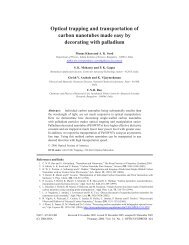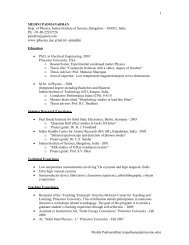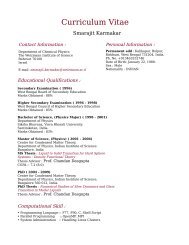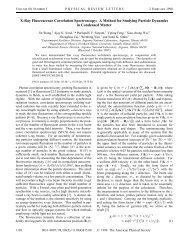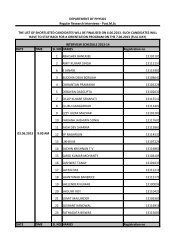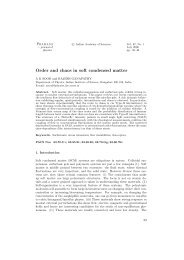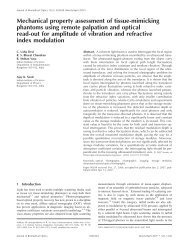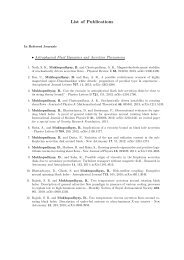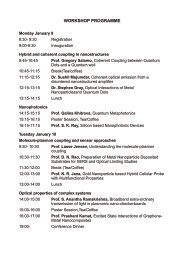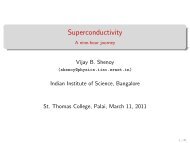Hydrodynamic Fluctuations and Instabilities in Ordered ... - Physics
Hydrodynamic Fluctuations and Instabilities in Ordered ... - Physics
Hydrodynamic Fluctuations and Instabilities in Ordered ... - Physics
You also want an ePaper? Increase the reach of your titles
YUMPU automatically turns print PDFs into web optimized ePapers that Google loves.
VOLUME 89, NUMBER 5 PHYSICAL REVIEW LETTERS 29JULY 2002<br />
0.8<br />
1.4<br />
0.6<br />
0.4<br />
0.2<br />
θ<br />
c bt1<br />
c bt2<br />
1.2<br />
1<br />
0.8<br />
0.6<br />
0.4<br />
0.2<br />
c s3<br />
θ<br />
c s1<br />
c s2<br />
c s3<br />
0<br />
0 0.1 0.2 0.3 0.4<br />
Sound speed ( <strong>in</strong> units of v 0<br />
)<br />
FIG. 1. A polar plot of speed of the bend-twist modes as a<br />
function of the angle between the propagation direction <strong>and</strong><br />
the z axis.<br />
polar <strong>and</strong> nematic phases, are simply the deviations n ?<br />
^n ^z. In polar-ordered suspensions, the drift velocity of<br />
SPPs relative to the fluid is v 0 ^n. S<strong>in</strong>ce these are driven<br />
systems, the forces enter<strong>in</strong>g the equations of motion need<br />
not arise from a free-energy functional, <strong>and</strong> any term not<br />
explicitly forbidden by symmetry or conservation laws<br />
must be <strong>in</strong>cluded. Moreover, there are a priori no relations<br />
among the phenomenological parameters other than those<br />
0<br />
0 0.2 0.4 0.6 0.8 1<br />
Sound speed ( <strong>in</strong> units of v ) 0<br />
FIG. 2. A polar plot of the speed of the splay-concentration <strong>and</strong><br />
drift waves as a function of the angle between the propagation<br />
direction <strong>and</strong> the z axis.<br />
required by the geometrical symmetries of the problem.<br />
Note that our coarse-gra<strong>in</strong>ed description applies on length<br />
scales a, the particle size.<br />
We now present the equations of motion which follow<br />
from these arguments, <strong>and</strong> expla<strong>in</strong> the physical orig<strong>in</strong> of<br />
the terms there<strong>in</strong>. We beg<strong>in</strong> with the polar-ordered case.<br />
The equations for the nematic case follow by dropp<strong>in</strong>g<br />
terms which violate z ! z symmetry. The director field<br />
obeys<br />
1<br />
@ t n ? 1 v 0 @ z n ? 1 r ? c<br />
2 @ 1<br />
zu ? r ? u z<br />
2 2 @ z u ? r ? u z ... (1)<br />
The first term on the right-h<strong>and</strong> side of (1) represents<br />
advection of distortions by the mean drift v 0 [16]. The<br />
second says simply that SPPs move from high to low result of the self-propell<strong>in</strong>g activity. We must allow for<br />
concentration—a nonequilibrium ‘‘osmotic pressure.’’ such a term because no symmetry can rule it out <strong>in</strong> these<br />
These terms are a consequence of the lack of z ! z<br />
symmetry, <strong>and</strong> are present <strong>in</strong> the model of [6,8,9] as<br />
well. The third term on the right says that <strong>in</strong> the absence<br />
of other forces the director rotates at the same rate as the<br />
fluid. Together with the fourth term, conta<strong>in</strong><strong>in</strong>g the phenomenological<br />
parameter 2, this gives rise to the ‘‘flowalignment’’<br />
[14,17] phenomenon, well-known <strong>in</strong> nematic<br />
hydrodynamics. These two terms are, of course, absent <strong>in</strong><br />
[6,8,9] <strong>and</strong> are central to our work. The ellipsis <strong>in</strong> (1)<br />
subsumes diffusive terms of higher order <strong>in</strong> gradients, as<br />
well as nonl<strong>in</strong>ear terms.<br />
The equation of motion for g has the form @ t g i<br />
r j<br />
ij , as <strong>in</strong> any momentum-conserv<strong>in</strong>g system, where<br />
ij is the stress tensor. What dist<strong>in</strong>guishes SPP systems is a<br />
p<br />
contribution ij / n i n j 1=3 ij to the shear stress, as a<br />
driven systems [18]. To derive from the dynamics of<br />
<strong>in</strong>dividual SPPs note that, by Newton’s Third Law, the<br />
forces exerted by an SPP on the fluid <strong>and</strong> by the fluid on<br />
an SPP are equal <strong>and</strong> opposite; i.e., the comb<strong>in</strong>ed system of<br />
SPPs fluid is force-free. Thus, <strong>in</strong> the equation of motion<br />
for the total momentum density g, the force density associated<br />
with each SPP <strong>and</strong> the ambient fluid must <strong>in</strong>tegrate<br />
to zero. Averag<strong>in</strong>g over the detailed swimm<strong>in</strong>g movements,<br />
it follows that the simplest model for, say, the th<br />
SPP is a rod with axis ^n t , at time t, with po<strong>in</strong>t forces of<br />
equal magnitude f on its ends, directed along ^n [19].<br />
For a collection of SPPs with centers at r t <strong>and</strong> ends at<br />
r a ^n <strong>and</strong> r a 0 ^n , where we have allowed for force<br />
centers asymmetrically disposed about the center of the<br />
SPP, this yields a force density (divergence of stress)<br />
058101-2 058101-2<br />
p<br />
ij



